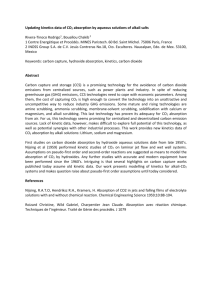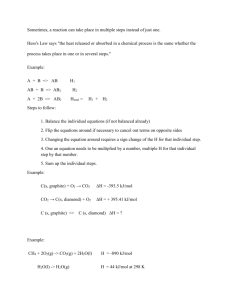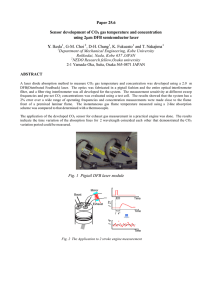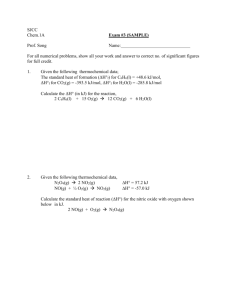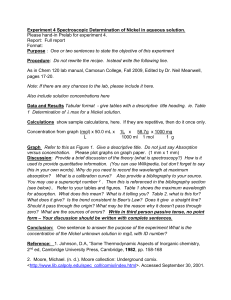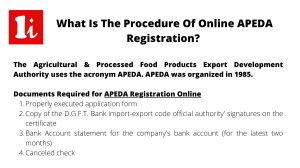Document 13359608
advertisement
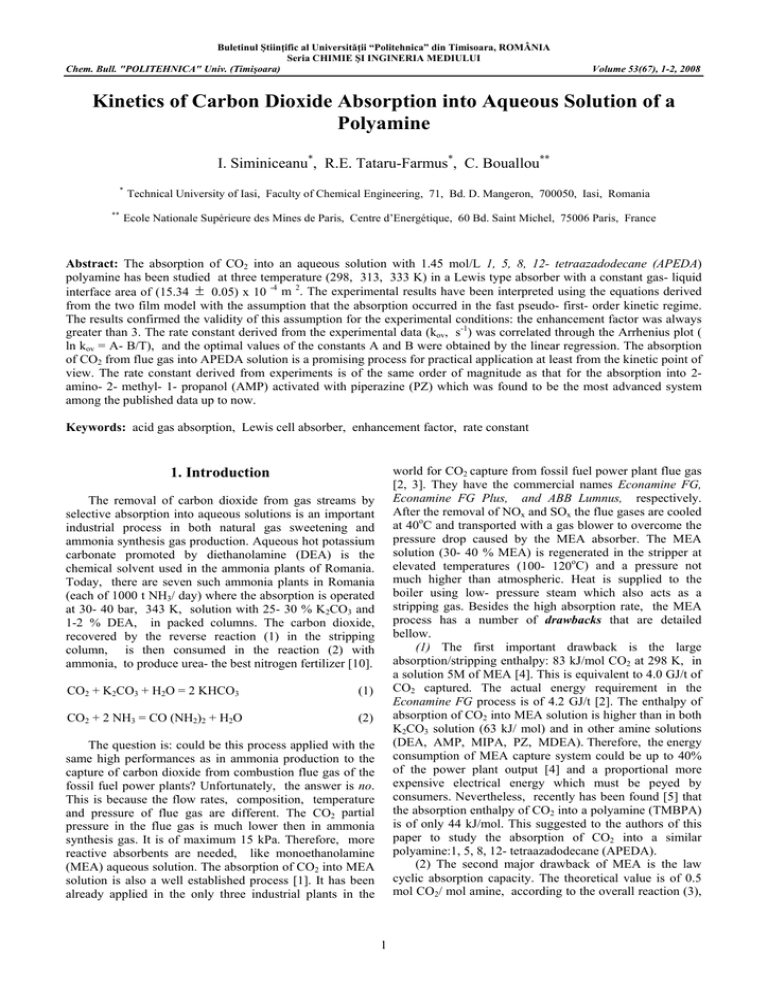
Buletinul Ştiinţific al Universităţii “Politehnica” din Timisoara, ROMÂNIA
Seria CHIMIE ŞI INGINERIA MEDIULUI
Chem. Bull. "POLITEHNICA" Univ. (Timişoara)
Volume 53(67), 1-2, 2008
Kinetics of Carbon Dioxide Absorption into Aqueous Solution of a
Polyamine
I. Siminiceanu*, R.E. Tataru-Farmus*, C. Bouallou**
*
**
Technical University of Iasi, Faculty of Chemical Engineering, 71, Bd. D. Mangeron, 700050, Iasi, Romania
Ecole Nationale Supérieure des Mines de Paris, Centre d’Energétique, 60 Bd. Saint Michel, 75006 Paris, France
Abstract: The absorption of CO2 into an aqueous solution with 1.45 mol/L 1, 5, 8, 12- tetraazadodecane (APEDA)
polyamine has been studied at three temperature (298, 313, 333 K) in a Lewis type absorber with a constant gas- liquid
interface area of (15.34 ± 0.05) x 10 -4 m 2. The experimental results have been interpreted using the equations derived
from the two film model with the assumption that the absorption occurred in the fast pseudo- first- order kinetic regime.
The results confirmed the validity of this assumption for the experimental conditions: the enhancement factor was always
greater than 3. The rate constant derived from the experimental data (kov, s-1) was correlated through the Arrhenius plot (
ln kov = A- B/T), and the optimal values of the constants A and B were obtained by the linear regression. The absorption
of CO2 from flue gas into APEDA solution is a promising process for practical application at least from the kinetic point of
view. The rate constant derived from experiments is of the same order of magnitude as that for the absorption into 2amino- 2- methyl- 1- propanol (AMP) activated with piperazine (PZ) which was found to be the most advanced system
among the published data up to now.
Keywords: acid gas absorption, Lewis cell absorber, enhancement factor, rate constant
world for CO2 capture from fossil fuel power plant flue gas
[2, 3]. They have the commercial names Econamine FG,
Econamine FG Plus, and ABB Lumnus, respectively.
After the removal of NOx and SOx the flue gases are cooled
at 40oC and transported with a gas blower to overcome the
pressure drop caused by the MEA absorber. The MEA
solution (30- 40 % MEA) is regenerated in the stripper at
elevated temperatures (100- 120oC) and a pressure not
much higher than atmospheric. Heat is supplied to the
boiler using low- pressure steam which also acts as a
stripping gas. Besides the high absorption rate, the MEA
process has a number of drawbacks that are detailed
bellow.
(1) The first important drawback is the large
absorption/stripping enthalpy: 83 kJ/mol CO2 at 298 K, in
a solution 5M of MEA [4]. This is equivalent to 4.0 GJ/t of
CO2 captured. The actual energy requirement in the
Econamine FG process is of 4.2 GJ/t [2]. The enthalpy of
absorption of CO2 into MEA solution is higher than in both
K2CO3 solution (63 kJ/ mol) and in other amine solutions
(DEA, AMP, MIPA, PZ, MDEA). Therefore, the energy
consumption of MEA capture system could be up to 40%
of the power plant output [4] and a proportional more
expensive electrical energy which must be peyed by
consumers. Nevertheless, recently has been found [5] that
the absorption enthalpy of CO2 into a polyamine (TMBPA)
is of only 44 kJ/mol. This suggested to the authors of this
paper to study the absorption of CO2 into a similar
polyamine:1, 5, 8, 12- tetraazadodecane (APEDA).
(2) The second major drawback of MEA is the law
cyclic absorption capacity. The theoretical value is of 0.5
mol CO2/ mol amine, according to the overall reaction (3),
1. Introduction
The removal of carbon dioxide from gas streams by
selective absorption into aqueous solutions is an important
industrial process in both natural gas sweetening and
ammonia synthesis gas production. Aqueous hot potassium
carbonate promoted by diethanolamine (DEA) is the
chemical solvent used in the ammonia plants of Romania.
Today, there are seven such ammonia plants in Romania
(each of 1000 t NH3/ day) where the absorption is operated
at 30- 40 bar, 343 K, solution with 25- 30 % K2CO3 and
1-2 % DEA, in packed columns. The carbon dioxide,
recovered by the reverse reaction (1) in the stripping
column, is then consumed in the reaction (2) with
ammonia, to produce urea- the best nitrogen fertilizer [10].
CO2 + K2CO3 + H2O = 2 KHCO3
(1)
CO2 + 2 NH3 = CO (NH2)2 + H2O
(2)
The question is: could be this process applied with the
same high performances as in ammonia production to the
capture of carbon dioxide from combustion flue gas of the
fossil fuel power plants? Unfortunately, the answer is no.
This is because the flow rates, composition, temperature
and pressure of flue gas are different. The CO2 partial
pressure in the flue gas is much lower then in ammonia
synthesis gas. It is of maximum 15 kPa. Therefore, more
reactive absorbents are needed, like monoethanolamine
(MEA) aqueous solution. The absorption of CO2 into MEA
solution is also a well established process [1]. It has been
already applied in the only three industrial plants in the
1
Chem. Bull. "POLITEHNICA" Univ. (Timişoara)
Volume 53(67), 1-2, 2008
(0.3504±0.0005) *10-4 m3. The temperature is kept
constant within 0.05 K by circulating a thermostatic fluid
through the double glass jacket. The liquid phase is agitated
by a six bladed Rushton turbine (4.25x 10-2 m diameter).
The gas phase is agitated by 4x10-2 m diameter propeller.
Both agitators are driven magnetically by a variable speed
motor. The turbine speed is checked with a stroboscope.
The kinetics of gas absorption is measured by
recording the absolute pressure drop through a SEDEME
pressure transducer, working in the range (0 to 200) x103
Pa. A microcomputer equipped with a data acquisition card
is used to convert the pressure transducer signal directly
into pressure P units, using calibration constant previously
determined, and records it as function of time.
based on the carbamate formation through the zwitterions
mechanism:
CO2 + 2 HOCH2CH2NH2= HOCH2CH2NCOO- +
HOCH2CH2NH+2
(3)
The practical value is of only 0.35 (from 0.2 of the lean
solution to 0.45 of the carbonated solution).Therefore, the
MEA process needs about 55 m3 solution /ton CO2
captured. The polyamine named TMBPA has a saturation
loading of 3 mol CO2/ mol amine [5]. A higher cyclic
capacity reduces the flow rate of the solution needed.
APEDA is expected to have a cyclic absorption capacity of
2 because it includes two primary and two secondary amine
groups in the molecule.
(3) The third important disadvantage of MEA is its
degradability. The reactions of MEA with NOx, SOx, CO
and O2 which accompany the CO2 in flue gases leads to
heat- stable salts which must be purged from the
recirculated solution [6]. These salts mainly consist of
formate (87%),
acetate (4.6%),
oxalate (0.2%),
thiocyanate(6.8%), thiosulphate(1.2%) and sulphate(0.2%).
The production of these salts could be from 3.729 to 14.917
kg/ t CO2 captured [7]. This means that up to 10% of active
amine is lost through degradation. It must be noted that the
degradation oxidative reactions of MEA begin by the attack
at the alcohol function of the alkanol radical [8]. The
replacement of MEA with an alkyl amine could avoid or
mitigate the degradation reactions.
(4) The presence of heat- stable salts in the absorption
solution causes a number of adverse effects: reduction of
amine absorption capacity, increase in foaming tendency
of the solution, increase in solution viscosity, increase in
corrosion,
reduced filter runtime due to the solid
precipitation in solution. Consequently, the solution must
contain at least three types of additives: oxygen scavengers
(OS), corrosion inhibitors (CI), and antifoam agents
{AA). These special additives make the MEA solution an
expensive one. The estimated cost of CO2 capture by
absorption in MEA solution was evaluated at EUR 39.3/
tone of CO2 avoided [3]. This could increase the cost of
electricity production by 82.8 % (from EUR 31.4/MWh to
EUR 57.4/ MWh). APEDA is not an alakanolamine and
could be not degraded by oxidation with SOx, CO and O2.
In addition, APEDA is frequently used as ingredient for
corrosion inhibitors [11].
The objective of this work was to study the kinetics of
CO2 absorption into APEDA aqueous solution. The
originality of the present work consists of two things: the
solvent, and the apparatus. The solvent was a 1.45 M
APEDA aqueous solution, a polyamine which has not yet
been used for the CO2 absorption. The apparatus is
described in the next section.
Water and APEDA are degassed independently and
aqueous solutions are prepared under a vacuum. The
amounts of water and amines are determined by differential
weightings to within ±10-2g.
This uncertainty on weightings leads to uncertainties in
concentrations of less then ± 0.05%.
The flask containing the degassed APEDA aqueous
solution is connected to the absorption cell by means of a
needle introduced through the septum situated at the
bottom of the cell. Weighing the flask with the tube and the
needle before and after transfer allows the determination of
the exact mass of solvent transferred into the cell.
Variable
volume
Vacuum
MC
Acid
gas
Vapor Phase
Baffles
Glass double jacket
Liquid Phase
Magnetic
stirrer
Tube of load
solvent
Temperature
probe
Figure 1. Flow diagram of the absorption equipment
Once the amine aqueous solution is loaded and the
temperature equilibrated,
the inert gas pressure Pi
corresponding mainly to the solvent vapor pressure plus
eventual residual inert gases is measured. The pure CO2 is
introduced over a very short time (about 2 s) in the upper
part of the cell, the resulting pressure P0 is between (100200) x103 Pa. Then stirring is started and the pressure drop
resulting from absorption is recorded.
2. Experimental
The apparatus (Fig.1) is a Lewis type absorber with a
constant gas- liquid interface area of (15.34 ± 0.05) x 10 -4
m 2. The total volume available for gas and liquid phases is
2
Chem. Bull. "POLITEHNICA" Univ. (Timişoara)
Volume 53(67), 1-2, 2008
Doi = 2.35x10-6 exp (-2119/T)
The main materials involved have been: water, carbon
dioxide, 1, 5, 8, 12- Tetraazadodecane (APEDA). Ordinary
twice-distilled water was used. Carbon dioxide, purchased
from Air Liquid, of 99.995% purity, was used as received.
APEDA from Alfa Aesar (Store Road, Heysham) material
certified 96.5 % was used as received.
Solution densities were measured with an Anton Paar
(Graz, Austria) vibrating tube densimeter, model DMA
512.
The presence of the amine in water decreases the gas
solubility (“salting out effect”). Taking into account the
influence of the ionic strength of the solution on the
solubility [10] with an equation of Sechenow type, the Hi
for the solution of 1.45 M APEDA was evaluated with
(11):
Hi= 1.113 xH0i
(11)
The diffusivity of CO2 in the APEDA aqueous solution
was evaluated with the equation(12), tested in a previous
work [14]:
Di = (Doi/ 2.43) ( μL/ μW)0.2
(12)
3. Results and discussion
The primary experimental results have been interpreted
on the basis of the gas- liquid chemical process theory
(Siminiceanu, 2004). The rate of the chemical absorption
of CO2 ( = i) is of the form (4):
(4)
The gas phase is assumed ideal (Pi Vg = ni RT), CO2 is
completely consumed by the reaction in the liquid film,
and the CO2 concentration at the interface is replaced by
the Henry law ( Cei = Pie / Hi ). The partial pressure of CO2
is obtained by subtraction of vapor pressure of the solution
(Pv) from the total measured pressure (PT): Pi = PT – Pv. By
integrating (4) under these assumptions, the equation (5) is
derived:
(5)
TABLE 1. Experimental and calculated data for the absorption of
CO2 in APEDA (1.45 M) aqueous solution at 298 K
a,
molCO2
/mol
APEDA
0.012
0.070
0.180
0.295
0.382
0.484
The enhancement factor E can be calculated for each
experiment, using the equation (6).
In order to compare our results with those for other
solutions at the same temperature, the overall rate constant
(kov) of the pseudo- first order reaction has been calculated
for the fast reaction regime ( E = Ha > 3 ) :
(7)
The mass transfer coefficient kL is calculated with the
equation (8) which was established, using the N2O
analogy, for the absorber also applied in these new kinetic
experiments [12]:
a,
molCO2
/mol
APEDA
0.047
0.109
0.222
0.330
0.430
0.518
(8)
Where the dimensionless Sherwood (Sh), Reynolds
(Re) and Schmidt (Sc) numbers have been defined as
follows:
Sh= kL0 Dc/ Di
Re= ρL N dst/ μL ;
E=Ha
kov , s-1
206.04
191.32
183.96
169.24
161.88
154.52
8 490.91
7 030.98
6 500.34
5 501.79
5 033.48
4 586.39
TABLE 2. Experimental and calculated data for the absorption of
CO2 in APEDA (1.45 M) aqueous solution at 333 K
0
Sh = 0.352 Re 0.618 Sc0.434
0.028
0.026
0.025
0.023
0.022
0.021
β
0.041
0.041
0.040
0.033
0.029
0.026
kl, m/s
2.49E-05
kov = (kL0 E )2 / Di
β
kl, m/s
1.96E-05
(6)
DCO, m²/s
2.00E-09
ln ( PT- Pv ) t/ (PT – Pv)to = - β ( t- to )
where
β= E kL0 ART/ Vg Hi
DCO, m²/s
2.23E-09
mol/ m2 s,
HI, Pa.m3/mol
2965.85
,
The ratio μL/μW has been correlated for the APEDA
solutions on the basis of experimental data published in a
previous paper [15].
The results from the table 2 (first row, for the same
loading) can be compared to those obtained for the
absorption of CO2 in a solution of AMP (1.5 M) with
different doses of PZ as activator, in a watted wall column
absorber at the same temperature and a loading a= 0.2880.031 [16].The value obtained in this work with APEDA
(kov= 17 255.51 s-1) is higher than kov for AMP with 0.1
and 0.2 M piperazine, and inferior to that for larger doses
of PZ. It must be noted that he solution AMP- PZ- H2O
gives the grates absorption rate among the new systems
studied in the literature in the last decades.
Hi, Pa.m3/mol
6098.76
- dni/ A dt = E koL Cei
(10)
E=Ha
kov ,
s-1
445.95
445.95
435.07
358.93
315.43
282.79
55 292.49
55 292.49
52 627.42
35 818.99
27 663.03
22 235.57
TABLE 3.The results for the absorption of CO2 in 1.5 M solutions
of AMP activated with PZ at 313 K [16]
Sc= μL/ ρL Di
CoPZ,
mol/
L
0.1
0.2
0.3
0.4
E being calculated with (6), using the experimental values
of β from the tables 1 and 2.
The Henry constant (Hoi) and the diffusion coefficient
o
(D i) for the system CO2- H2O have been calculated with
the equations (9) and (10), respectively [13]:
H0i = 2.8249x106 exp (-2044/T)
(9)
3
ax 102,
mol/
mol
3.11
2.88
3.10
3.16
koLx
105,
m/s
3.97
4.05
3.68
3.64
Di x109,
m2/s
1.72
1.66
1.57
1.42
Hi,
Pa m3/
mol
4 144
4 047
4 095
4 070
NA106,
kmol/
m2s
3.46
3.88
4.31
4.52
kov,
s-1
7 530
13 857
20 572
27 819
Chem. Bull. "POLITEHNICA" Univ. (Timişoara)
Volume 53(67), 1-2, 2008
According to the results, the rate constat (kov) increased
with the temperature, and decreased with the carbonation
degree/ loading (a= mol CO2/mol amine). For each loading
the Arrhenius equation was satisfactory verified (Fig.2).
The activation energy (41.9 kJ/mol) indicated that the
process proceeded close to the boundary between the
kinetic and the mass transfer regime. The optimal values of
the constants A and B from the Arrhenius equation (lnk =
A- B/T) were derived by linear regression, for each
loading (Table 4). These will be useful for the industrial
absorption column modeling and simulation.
The rate constant derived from experiments is of the
same order of magnitude as that for the absorption into 2amino- 2- methyl- 1- propanol (AMP) activated with
piperazine ( Table 3) which was found to be the most
advanced system among the published data up to now( Sun
et al., 2005). At T= 313 K and a< 0.05, for instance, kov =
17 255 s-1 for APEDA, compared to 20 572 s-1 for 1.5M of
AMP with 0.3M of PZ under the same conditions.
The preliminary results presented in this paper show
that, from the kinetic point of view, the absorption of CO2
from flue gas into APEDA solution is a promising process
for practical application .Other potential advantages of
APEDA compared to MEA: higher loadings( smaller
solution flow rates), less energy required for regeneration,
lower degradability and corrosiveness. It is still to prove
the unavoidable existence of some drawbacks, such as,
volatility, toxicity and cost.
11.50
11.00
ln k ov
10.50
10.00
a=0.00-0.05
a=0.05-0.10
a=0.10-0.20
a=0.20-0.30
a=0.30-0.40
a=0.40-0.50
9.50
9.00
8.50
3.00
3.10
3.20
3.30
1000/T, K-1
Figure 2. The Arrhenius plots for all experimental loadings
TABLE 4. The kinetic parameters derived from the Arrhenius plot
a
molCO2/mol
APEDA
cal/mol
kJ/mol
0.00-0.05
10 553.89
0.05-0.10
0.10-0.20
0
Ea
A= ln kov
B=Ea/R,
K
44.11
26.496
5 311.02
10 616.18
44.37
26.877
5 342.72
10 782.52
45.06
27.272
5 426.27
0.20-0.30
10.552.85
44.11
25.931
5 310.52
0.30-0.40
9 599.42
40.12
24.238
4 830.90
0.40-0.50
8 890.80
37.16
24.671
4 474.08
REFERENCES
1. Kohl, A.L., Nielsen, R., Gas Purification, 5th ed., Gulf Publ.Corp.,
Texas, 1997, pp. 250-281.
2. Abu- Zahra, M.R.M., Schneiders. L.H.J., Niederer. J.P.M., Feron
P.H.M., Geert, F., International Journal of Greenhouse Gas Control,
2007, 1, pp. 37- 46.
3. Abu- Zahra M.R, M., Niederer J.P.M., Feron P.H.M., Versteeg G.F.,
International Journal of Greenhouse Gas Control, 1, 2007, p. 136- 142.
4. Hilliard, M.D., Dissertation Proposal, University of Texas at Austin,
2005, p. 1-27.
5. Dallos, A., Altsach, T., Kotsis, L., J. Thermal Analaysis and
Calorimetry, 2001, 65, pp. 419- 423.
6. Bello, A., Idem, R.O, Ind. Eng. Chem. Res., 2005, 44, pp. 945- 969.
7. Thitakamol, B., Veawab, A., Aroonwilas, A., International Journal of
Greenhouse Gas Control, 2007, 1, pp. 318- 342.
8. Strazisar, B.R., Anderson, R.R., White, C.M., Energy Fuels, 2003,
17, pp. 1034-1039.
9. Tanthapanichakoon, W., Veawab, A., Mcgarvey, B., Ind. Eng. Chem.
Res., 2006, 45, pp. 2586- 2593.
10. Siminiceanu, I., Procese chimice gaz- lichid, Editura Tehnopres,
Iaşi, 2004, p. 180- 288.
11. http://www.chemicalland21.com/arokorhi/specialtychem/finechem/1,
5, 8, 12- TETRAAZADODECANE.
12. Amararrene, F., Bouallou, C.H., Ind. Eng. Chem. Res., 2004, 43,
pp. 6136-6141.
13. Versteeg, G.V., Van Swaaij, W.P.M., J. Che. Eng. Data, 1998, 33,
pp. 29- 34.
14. Siminiceanu, I., Tataru- Farmus, R.E., Amann, J.M., Buletinul Inst.
Polit. Iasi, 2006, Tom 52(56), 1-2, Chim. Ing. Chim., 45- 50.
15. Tataru-Farmus, R.E., Siminiceanu, I., Bouallou, C.H., Chemical
Engineering Transactions, 2007, 12, pp. 175-181.
16. Sun, W.C., Yong, C.B., Li, M.H., Chem. Eng. Sci., 2005, 60, pp. 503516.
4. Conclusions
The aqueous monoethanolamine (MEA) is now
considered the most convenient among the available
absorption technologies for removing carbon dioxide from
flue gas streams. Nevertheless, this process has a number
of drawbacks, pointed out in the introductory section of
this paper, which make it rather expensive. Its application
to fossil fuel power plants could increase the cost of
electricity production by up to 82.8 % [3]. This paper
presents some results of a study aiming to develop a new
solvent in order to improve the efficiency of the CO2
removal from flue gas.
The absorption of CO2 into an aqueous solution with
1.45 mol/L 1, 5, 8, 12- tetraazadodecane (APEDA)
polyamine has been studied at three temperature (298,
313, 333 K) in a Lewis type absorber with a constant gasliquid interface area of (15.34 ± 0.05) x 10 -4 m 2. The
experimental results have been interpreted using the
equations derived from the two film model with the
assumption that the absorption occurred in the fast pseudofirst- order kinetic regime. The results confirmed the
validity of this assumption for the experimental conditions:
the enhancement factor was always greater than 3.
4

